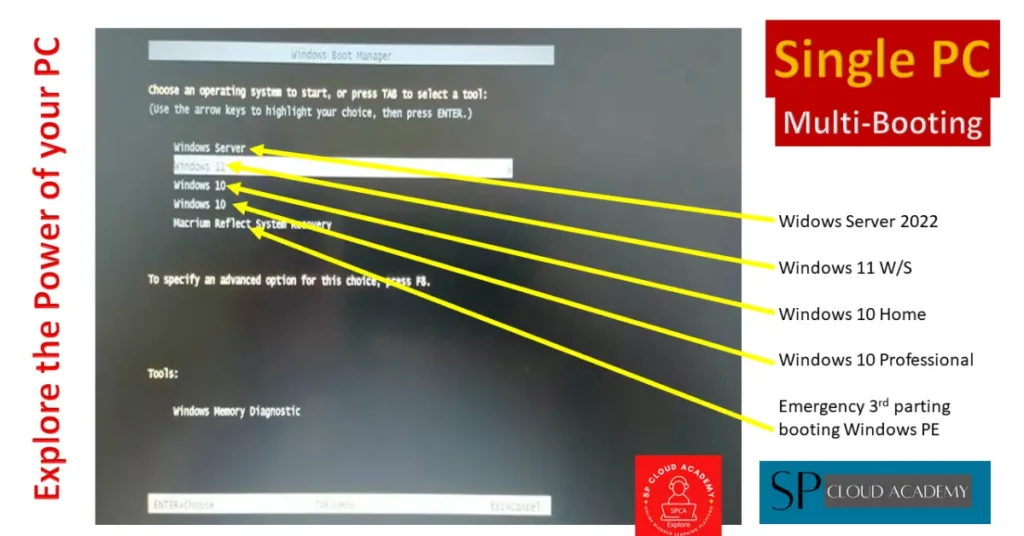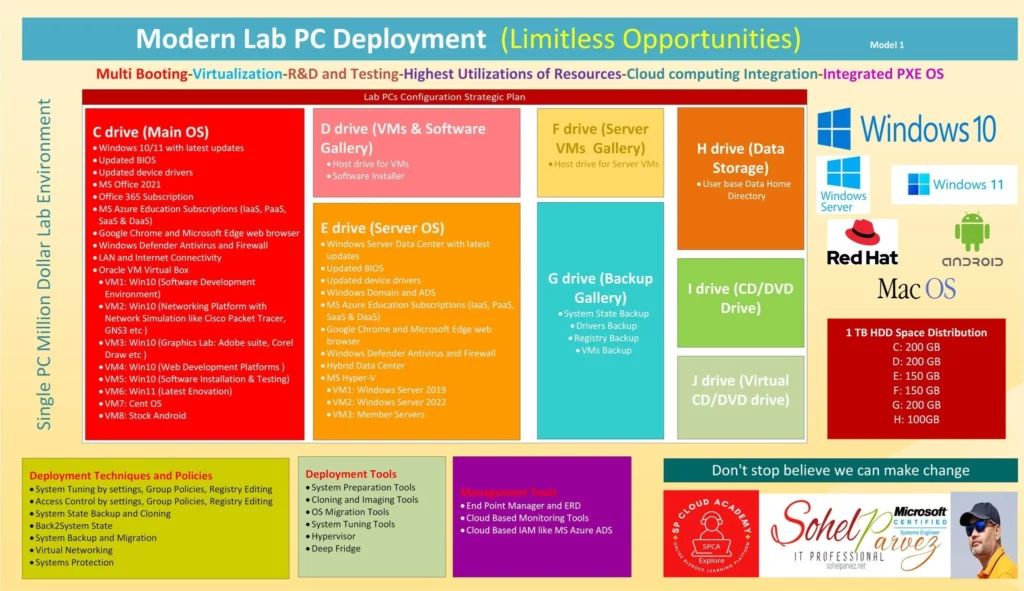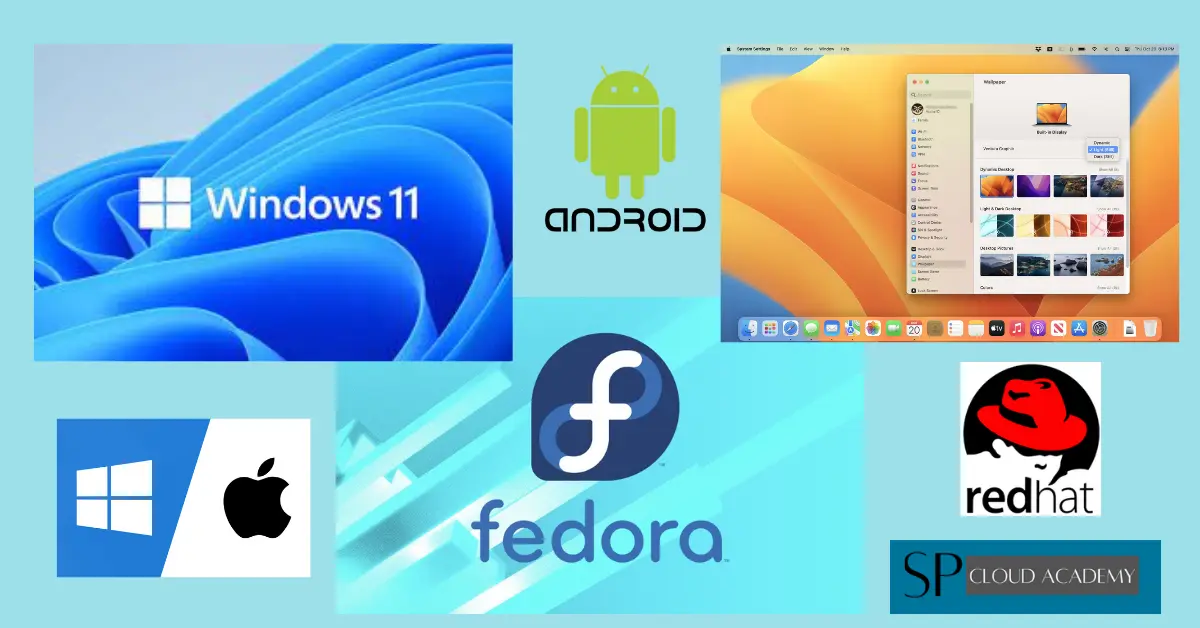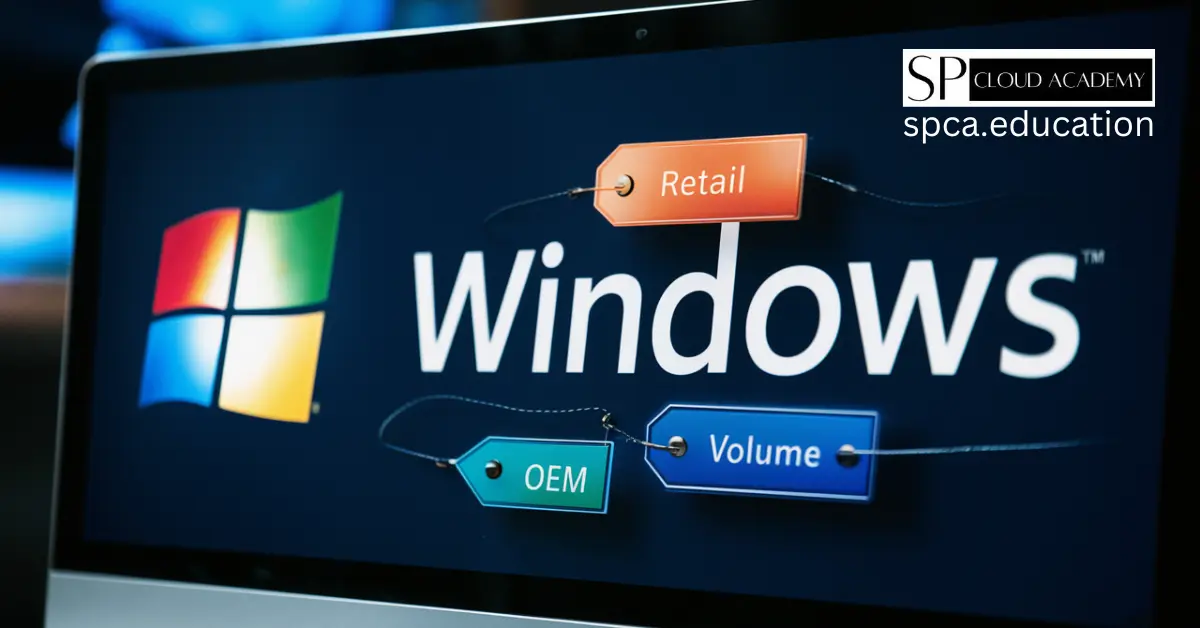A multi-boot environment on a single PC allows the installation and operation of multiple operating systems (OS) on one computer. This setup enables users to choose between different OSs at startup, making it ideal for tasks like software testing or maintaining diverse computing environments. Typically, each OS resides in its own partition, and a boot manager (like GRUB for Linux or Windows Boot Manager) lets users select the desired OS. Careful setup and maintenance are crucial to ensure smooth coexistence of these OSs, providing flexibility and versatility to the user without the need for multiple physical machines.

Benefits of Multi boot environment in single PC
A multi-boot environment on a single PC offers several benefits, making it a valuable setup for various purposes:
- Versatility: Multi-booting allows you to run multiple operating systems on a single machine. This versatility is useful for software developers, IT professionals, and enthusiasts who need access to different OSs for testing, development, or exploration.
- Compatibility Testing: You can test software and applications on multiple operating systems, ensuring cross-platform compatibility. This is crucial for developers creating software for various platforms.
- Security Testing: Security professionals can use multi-boot setups to test security tools and strategies on different OSs, helping them identify vulnerabilities and strengthen defenses.
- Education and Learning: Students and IT learners can use multi-boot setups to gain hands-on experience with various operating systems and software, enhancing their skills and knowledge.
- Legacy Software: Keep older operating systems or software versions installed for compatibility with legacy applications or hardware that are not supported on newer OSs.
- Data Recovery: In case of OS corruption or failures, having multiple OSs allows you to access your data through another OS, increasing the chances of data recovery.
- Isolation: You can isolate specific tasks or environments within separate OSs. For example, you can keep personal and work-related tasks separate, enhancing security and organization.
- Resource Allocation: Different operating systems can be optimized for specific tasks. You can allocate resources (CPU, RAM, etc.) differently for each OS based on its requirements.
- Privacy and Security: Maintain separate environments for sensitive tasks, such as online banking or accessing confidential data, to reduce the risk of security breaches.
- Customization: Customize each OS independently, including appearance, settings, and software installations, to suit your preferences and requirements.
- Troubleshooting: Use one OS to troubleshoot issues in another. If one OS becomes unstable or unbootable, you can diagnose and fix problems using a different OS.
- Backup and Recovery: Back up your data from one OS to another, providing an additional layer of data protection and disaster recovery.
- Minimal Hardware Costs: Instead of maintaining multiple physical machines, you can achieve the same functionality with a single PC, reducing hardware costs and power consumption.
- Exploration: Experiment with different operating systems and their features without the need for separate hardware, allowing you to broaden your knowledge and skillset.
- Reduced Clutter: Eliminate the need for multiple computers or virtual machines, reducing physical clutter and simplifying your workspace.
Overall, a multi-boot environment on a single PC offers flexibility, efficiency, and a range of use cases, making it a practical solution for users with diverse computing needs and interests.
Multi-boot environment vs. local virtual machine
- Multi-Boot Environment: Running multiple operating systems directly on a single PC, allowing you to choose which OS to use at startup.
- Local Virtual Machine: Running an operating system within another OS on the same PC, creating an isolated environment for testing or running different software.
Here’s a comparison between a multi-boot environment and a local virtual machine using a table format:
| Aspect | Multi-Boot Environment | Local Virtual Machine |
|---|---|---|
| Definition | Running multiple operating systems on a single computer, each in its own partition. | Running an OS within another OS through virtualization software (e.g., VirtualBox, VMware,Hyper-V). |
| Ease of Setup | Can be more complex, involving partitioning and OS installations. Requires rebooting to switch between OSs. | Generally easier and quicker to set up as it doesn’t require modifying partitions or rebooting. |
| Resource Isolation | OSs are completely isolated from each other, which can be advantageous for security and performance. | OSs run within a virtualized environment, sharing resources with the host OS. |
| Resource Utilization | Efficient use of hardware resources as each OS has direct access to hardware. | May consume more resources because of the overhead of virtualization. |
| Compatibility | Compatibility can be a concern, as not all hardware may work with every OS. | Provides better compatibility since VMs can run various OSs simultaneously. |
| Security and Isolation | Provides strong isolation between OSs, reducing the risk of malware and data breaches. | Offers isolation, but security vulnerabilities in the host OS can affect all VMs. |
| Flexibility | Limited flexibility for quickly switching between OSs; requires rebooting. | Highly flexible; you can easily create, copy, and move VMs. |
| Snapshot and Backup | Typically lacks built-in snapshot and backup features for individual OSs. | Allows creating snapshots and backups for VMs, simplifying recovery and testing. |
| Maintenance and Updates | Requires managing updates for each OS separately; updates can sometimes interfere with the boot manager. | Easier management of OS updates and maintenance, with less disruption to the host system. |
| Use Cases | Ideal for scenarios requiring full access to hardware, gaming, or specific OS features. | Suited for testing, development, and running multiple OSs on a single machine without hardware limitations. |
In summary, the choice between a multi-boot environment and a local virtual machine depends on your specific needs and priorities. Multi-boot setups offer direct hardware access and full OS capabilities but may require more effort to set up and manage. Local virtual machines are more flexible and can be quickly created and managed but introduce some resource overhead due to virtualization.
Considerations for multi-boot environment in single PC
Creating a multi-boot environment on a single PC can be a powerful tool, but it also comes with several considerations and potential challenges. Here are some key factors to keep in mind:
- Hardware Compatibility: Ensure that your PC hardware meets the requirements for all the operating systems you want to install. Some OSs may have specific hardware requirements that need to be met.
- Data Backup: Before you start the installation process, back up all your important data. There’s a risk of data loss during partitioning and OS installations.
- Partitioning: Properly partition your hard drive to allocate space for each OS. Be careful not to overwrite or delete partitions containing valuable data.
- Boot Loader: Choose a suitable boot loader (e.g., GRUB, Windows Boot Manager) to manage the boot process. Ensure it supports all the OSs you plan to install.
- Boot Order: Configure the boot order or default OS in the boot loader to match your preferences. This affects which OS starts by default and the order in which you can select them.
- File System Compatibility: Consider using common file systems (e.g., NTFS for Windows, ext4 for Linux) to facilitate data sharing between OSs.
- Updates and Maintenance: Regularly update and maintain each installed OS. Updates can affect the boot manager, so proceed with caution and make backups before major updates.
- Troubleshooting: Be prepared for potential issues like boot failures or conflicts between OSs. Having a troubleshooting plan and documentation can be invaluable.
- Security: Each OS should have its own security measures in place to protect against malware and unauthorized access. Be especially cautious in shared data areas.
- Data Management: Decide how you’ll manage data across different OSs. Shared partitions or network storage can facilitate data accessibility.
- License and Activation: Ensure that you have valid licenses and activation keys for each OS you install.
- Compatibility and Drivers: Some software and hardware may not work on all operating systems. Research compatibility and driver availability beforehand.
- Storage Space: Consider the size of your hard drive or SSD. Multiple OS installations can consume a significant amount of storage.
- Virtualization: If you only need occasional access to other OSs, consider using virtualization software like VirtualBox or VMware instead of a full multi-boot setup.
- Legal and Licensing: Be aware of the licensing agreements for the OSs you install. Some may restrict the number of installations or require separate licenses for each.
- Documentation: Keep thorough documentation of your multi-boot setup, including partition layouts, configurations, and passwords.
- Regular Backups: Continuously back up your data to mitigate the risk of data loss due to unforeseen issues.
- Stay Informed: Stay informed about updates, best practices, and potential compatibility issues related to your installed OSs.
By carefully considering these factors and planning your multi-boot setup, you can create a versatile and efficient computing environment that meets your needs while minimizing potential issues.
Setting up a multi-boot environment
Setting up a multi-boot environment with Windows-based operating systems on a single PC
Setting up a multi-boot environment with Windows-based operating systems on a single PC involves several steps. Here’s a general process:
Note: This example assumes you want to set up a multi-boot environment with Windows 10 and Windows 11, but the process is similar for other Windows versions.
Prerequisites:
- Windows installation media for Windows 10 and Windows 11 (USB drives or DVDs).
- Back up all important data.
Steps:
Partition Your Hard Drive:
- Open “Disk Management” in your current Windows installation.
- Shrink your existing partition to create space for the new OS installations.
Create Bootable Media:
- Download the Windows 10 and Windows 11 ISO files from Microsoft’s official website.
- Create bootable USB drives or DVDs using tools like Rufus (for USB drives) or Windows Media Creation Tool (for DVDs).
Install Windows 10:
- Insert the bootable Windows 10 media.
- Boot from the media by selecting it as the boot device.
- Follow the installation wizard, selecting the newly created partition for Windows 10.
- Complete the installation process.
Install Windows 11:
- Insert the bootable Windows 11 media.
- Boot from the media.
- Follow the installation wizard, selecting another partition (different from the one with Windows 10).
- Complete the installation process.
Configure Boot Manager:
- By default, Windows will set up its bootloader and create a boot menu.
- If the boot menu doesn’t appear, you may need to repair the bootloader using the Windows installation media and the “Repair your computer” option.
Testing:
- Reboot your PC and test the multi-boot setup. You should see a menu allowing you to choose between Windows 10 and Windows 11 at startup.
Optional: Adjust Boot Order:
- You can adjust the boot order or default OS in the boot menu to suit your preferences.
Post-Installation Configuration:
- Customize each Windows installation to your liking, install software, and set up user accounts.
Regular Maintenance:
- Keep both Windows installations up to date with the latest updates and security patches.
Backup and Data Management:
- Consider creating a shared data partition that both Windows installations can access. This makes it easier to manage and access your files from either OS.
Remember that the process might vary slightly depending on your specific hardware and the versions of Windows you’re using. Always back up your data and proceed with caution during partitioning and installation to avoid data loss or other issues.
Windows and other type os like linux, Mac OS based multi-boot environment setup
Setting up a multi-boot environment with Windows, Linux, and macOS (if you have compatible hardware) on a single PC can be a bit more complex due to the different operating systems involved. Here’s a general process for setting up such a multi-boot configuration:
Note: Ensure you have backups of all important data before proceeding, as this process involves repartitioning your hard drive.
Prerequisites:
- Installation media for Windows (e.g., Windows 10), Linux (e.g., Ubuntu), and macOS (if supported by your hardware).
- Back up all essential data.
Steps:
Partition Your Hard Drive:
- Open “Disk Management” in your current Windows installation.
- Shrink your existing Windows partition to create space for the other OS installations.
- Create partitions for Linux and macOS (if needed). Ensure compatibility with your target OSs (e.g., macOS requires an APFS-formatted partition).
Create Bootable Media:
- Download the installation ISO files for Windows, Linux, and macOS (if applicable) from their official sources.
- Create bootable USB drives for each OS using tools like Rufus (for Windows), UNetbootin (for Linux), and createinstallmedia (for macOS).
Install Windows:
- Insert the bootable Windows media.
- Boot from the media.
- Follow the installation wizard, selecting the partition created for Windows.
- Complete the installation process.
Install Linux:
- Insert the bootable Linux media.
- Boot from the media.
- Follow the installation wizard, selecting a separate partition for Linux (e.g., ext4 filesystem).
- Install the Linux bootloader (usually GRUB) to the same partition where you install Linux, not the MBR.
Install macOS (if applicable):
- This step may not be possible on all non-Apple hardware due to compatibility issues.
- Insert the macOS bootable media (created on a Mac).
- Boot from the media.
- Follow the macOS installation process, selecting the APFS-formatted partition for installation.
Configure Boot Manager:
- Upon rebooting, you may need to configure the boot manager to recognize all three OSs.
- Tools like rEFInd or Clover can help manage boot options.
Testing and Customization:
- Reboot your PC and test the multi-boot setup. Ensure you can access all three operating systems.
- Customize each OS to your preferences, install software, and set up user accounts.
Regular Maintenance:
- Keep all OSs up to date with the latest updates and security patches.
Data Management:
- Consider creating shared partitions (e.g., NTFS or exFAT) for data accessible by all OSs to simplify data management.
Backups:
- Regularly back up your data to prevent data loss during updates or potential issues with the multi-boot setup.
Please note that setting up macOS on non-Apple hardware, known as a Hackintosh, can be challenging and may not be legal in some regions due to macOS licensing restrictions. Ensure you understand the legal and technical implications before attempting this. Additionally, hardware compatibility for macOS varies widely, and not all PC configurations can successfully run macOS.
Running a multi-boot environment and virtual PCs simultaneously on a single PC
Running a multi-boot environment and virtual PCs simultaneously on a single PC offers a remarkable level of flexibility and versatility for various computing scenarios. In a multi-boot setup, you can install and run multiple operating systems directly on your hardware, each in its own partition. This allows you to have full access to your computer’s resources, making it ideal for tasks like gaming, software development, or exploring different operating systems.
On the other hand, virtualization software such as VirtualBox, VMware, or Hyper-V enables you to create and run virtual machines (VMs) within your primary operating system. These VMs function as self-contained environments, each with its own OS and applications. This approach is excellent for tasks like software testing, sandboxing potentially harmful applications, or running multiple instances of an OS simultaneously.
By combining both approaches, you gain unparalleled versatility. You can, for instance, have a multi-boot setup with Windows, Linux, and macOS on your PC while simultaneously running virtual machines for various purposes—say, a Linux VM on your Windows installation or a Windows VM within your Linux environment. This configuration empowers you to seamlessly switch between native and virtualized environments, catering to your specific computing needs at any given time. However, it’s essential to manage your system’s resources carefully to ensure optimal performance in both scenarios.

See Also
https://spca.education/oracle-vm-virtualbox/
https://spca.education/personal-computer-networking-lab-deployment/
https://spca.education/personal-it-environment-development-for-rd/



